| . 1 . 2 . 3 . 4 . >> |
| Author |
Message |
DRP
Member
|
# Posted: 29 Apr 2025 08:17pm - Edited by: DRP
Reply
Some random wood related stuff from today. I've replaced our old french doors and needed to make new trim, the new doors are slightly smaller than the old so I dug out some oak from the barn attic. The first pic is of freshly finished red oak and 30+ year old. Same finish (Waterlox). The trees were within 100' of each other. The difference is just time, sun and oxidation.
The second pic was from doing some cleanup of the old collapsed house on the neighbor's property. The previous owner was a packrat. I haven't seen any in a few decades but celotex, a fiberboardish wood fiber sheet with an asphalt coating was the go to sheathing from my youth through about the 90's. Around 2000 is when the IRC and the ever expanding wall chapter of the code kicked in.
Edit; Looking at the oak pic, the wood is flatsawn, roughly tangent to the rings. The "chicken scratches" you can see in both sticks is the end on view of medullary rays, the radial, in/out transport cells of a tree. They are obvious in the oaks, white oak having the largest.
|
|
DRP
Member
|
# Posted: 30 Apr 2025 04:28pm
Reply
After mentioning the rays yesterday, the middle board in this pic popped as I walked by today. That is quartersawn, like a spoke on a wheel, a straight radius line from heart to bark. So in that board the saw passed in line with the medullary rays and shows them off. They are only a cell or two thick, multiple cells tall and quite a few long. They also tend to flash as the angle of light and sight changes, the tiger eye effect, "chatoyance".
|
|
DRP
Member
|
# Posted: 1 May 2025 10:39pm
Reply
I was cleaning up the computer and saw this pic. Its a scan from an old Forest Products Labs publication. Sort of newsprint quality but they were testing the thinking that high rings per inch counts is an indication of some type of higher quality. If strength, stiffness, and fastener capacity are the qualities we're looking for, that is the denser piece with a higher percentage of latewood, the dark rings.
I've been studying this picture since I was about 16. They did I think kind of bias the picture to make a point, and it does. Faster growth does not necessarily mean a stick is inferior to an older growth one. But neither is the opposite. That fast grown plantation fir has the highest density, in the pictured sample group. In framing you want denser lumber under the higher loads, kitchen, bath, workbench. For that its not about how many rings per inch the wood has, look for the overall highest percentage of strong dark latewood, fast or slow grown. If all things are equal, pick the heavier stick. All things are never equal when you're looking for the strongest stick, knots, slope of grain...overall where does each piece fall within the grade is all part of it, density is another one of the things you're looking at in the sort.
The other foot that then falls in all that, what shrinks, wood does. What shrinks more, denser wood, Dang!
If you're making a door panel where stability is the quality that means the most, lower density might be a better choice.
If they were trying to create a strong beam why isn't the strongest fiber on the bottom? They do that better now.
|
|
MtnDon
Member
|
# Posted: 3 May 2025 09:09am
Reply

|
|
DRP
Member
|
# Posted: 3 May 2025 06:43pm
Reply
Thanks MD, I was hoping to jot down stuff as it comes to mind, hopefully some is of use to someone.
Mentioning density in relation to fastener strength... I'll attach a scan of one of the nail load tables from the NDS, National Design Specification for Wood Construction. We look to the building code where the engineer uses the NDS more. For instance the building code might specify 2 nails per bearing in a certain situation. If I step outside of the provisions of the code tables, an engineer having to figure it out from scratch is going to calculate the loads and then find the allowable load per fastener in the NDS and then design the connection that way.
The takeaway here is, while sorting through the stack, density holds fasteners better and gives higher load capacity. Notice in the table below the allowable load is directly related to wood density. If its a girder or ledger with a blue million joist hanger nails to go in it... pick the heavy hard one that's a bear to drive nails in, Dang!
There are pages of tables for different situations so as with many of those things, finding the correct table or equation to match the condition is critical.
|
|
MtnDon
Member
|
# Posted: 3 May 2025 09:28pm
Reply
Interesting table.
Do you know what the AWC connection calculator assumes about wood density?
|
|
MtnDon
Member
|
# Posted: 3 May 2025 09:32pm - Edited by: MtnDon
Reply
Ooops. Post duplicated
|
|
DRP
Member
|
# Posted: 4 May 2025 09:08am - Edited by: DRP
Reply
AWC/AFPA (American Wood Council/ American Forest and Paper Association) is the people who publish the NDS, the connections calc and the tables in the codebook. Basically they are the authority on structural wood. We can access their information at a basic level in the codebook, a much expanded level in the connections calc and the deep dive is in the NDS and associated papers.
I have not checked them but the connections calc should spit out very close to the same numbers as the tables in the NDS.
Open the connections calc here;
https://awc.org/calculators/connection-calculator/
Under Main and side member type click on that line and a drop down list of species will appear. You can change from the default Dougfir/Larch to any of the other species listed.
The calc and tables are using the average density of each species but as you can see they aren't listing density in the calc. As we make things easier to use it is easy to start losing the understanding behind what is going on.
Each species does have an average density but within the group there will be some sticks that are approaching "unusually light" (Weaker with less than normal latewood and lower nail holding ability) and others that approach "Dense" (Stronger, stiffer, better connection capacity).
The engineer uses the allowable strengths when doing design, everything in the pack "should" be up to that standard. A laborer builds with whatever stick lands in his hands and that "should" be good enough. A carpenter understands what he is looking at, understands what the engineer needs, and chooses placement more carefully when needed. Knowing that within a pack there are some pieces that are better suited to high loads and heavier connections a person can use pieces to their best advantage.
Thus far I've been showing a shear (lateral) loading table. Withdrawal is the other type of loading, pull out. First, don't load in withdrawal if there is any other way out of the problem, shear is more reliable. For example, people building with green lumber ignore several things. One of those is that a nail driven into green wood which then dries loses 75% of its withdrawal strength, so go carefully. Anyway, withdrawal is mostly about density, diameter and depth of penetration.
|
|
|
DRP
Member
|
# Posted: 6 May 2025 11:39am - Edited by: DRP
Reply
Cleaning up from the ice storm has had me up close and personal with our white pines the past few days. They are just beginning to put on the lighter, wider, lower density, earlywood portion of the annual growth ring. The trees are candling, over the next 30-60 days they will grow about 3' in height and 1/2" or so in diameter. The real growth spurt for most trees happens May-June. The rest of the year is spent on the latewood band, the narrower, denser, darker portion of an annual growth ring.
I mentioned our EWP's grow about 3' per year. The same species growing in NH or VT grows about half that amount per year. The rings are about twice as tight and the knots about half the distance apart.
We were building a big house with lots of porch ceiling. I had ordered what I thought was enough white pine T&G to do the whole job, and I was a little miffed when the local building supply delivered it and it had come from up north... wtf, we have a mill 20 miles away producing this stuff. Buy local whenever possible! I also had some transit damage that needed adjustment. Sure enough I ran a little short. Rather than order again I went to that local mill and bought the remainder. We began nailing it up and as we sat there eating lunch I looked at the new wood, and the yankee wood, and we took nown the new wood after lunch and called in an order for more northern pine. Same species but not a match  . .
|
|
DRP
Member
|
# Posted: 8 May 2025 09:09pm - Edited by: DRP
Reply
A few posts ago I was talking about the rays in wood. One thing to think about is they also form a natural cleavage plane wherever a ray is. When I'm sawmilling any of the oaks when it is bright and very dry like this time of year, it is easy to start checks in the wood in a short time on direct sunlight, the checks begin at a ray on the surface.
Anyway, what brought that back to mind, I was in Hawkins Mechanical Dictionary from 1909 this morning, and this popped up;
Felt Grain: 1. The grain or split timber which is transverse to the annular rings.
2. The act of splitting timber by the felt grain.
I believe they were describing medullary rays 
|
|
MtnDon
Member
|
# Posted: 9 May 2025 05:28pm - Edited by: MtnDon
Reply
Quoting: DRP I mentioned our EWP's grow about 3' per year. The same species growing in NH or VT grows about half that amount per year.
Climate makes a real difference.
We had to take down a blue spruce here at home in the NM high desert (5500 foot plateau that gets a historical annual average precipitation of 8.2".) I didn't do it myself as there are a couple of low concrete block walls very close by, plus underground power lines with a distribution box within 2 feet. Not to mention the nearby house. So we contracted with an old-time, insured, local tree care company.
They used a bucket boom truck to dismantle the tree from the top down. They also did a good clean-up. $1100.
The blue spruce was about 35 feet tall and 15" in diameter, about 2 feet above ground. I counted 44 growth rings, which looks about right as we planted the short little thing in 1985 or 86. About 9-10 years ago we cut back on the irrigation as water is darn expensive when the wells supplying the water are 3500 to 6500 feet deep, and we have been in drought conditions for most of the last 10 years.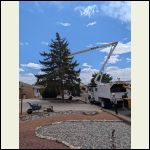
bucket boom
| 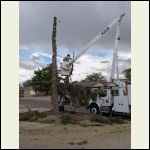
dismantling
| 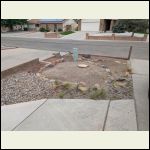
cleaned up
| 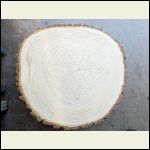
cookie, 44 years
|
|
|
DRP
Member
|
# Posted: 9 May 2025 08:47pm
Reply
That's cool, I think I can see where you got stingy with water and maybe nutrients. Prior to that it looks like a strong tree, lots of good dark latewood and dense wood overall.
Its comparing apples to oranges... but as I sit here on the yoga ball having come home early and had too much fun, I'll try to recollect what I just cut.
I'm still opening up sunlight below the garden by taking out the unthinned eastern white pines. I dropped 3 and brought out 9 sawlogs from 2 of them. I think all told they were probably 70-80' tall and I was getting ~50' that would produce a 4x4 or better. I expect an 8x10 and an 8x8 out of 2 logs at the butt end (counting my chickens before they hatch!) They were a good bit taller than yours but diameter would be pretty close.
The third tree was a little stunted peckerpole. I failed to factor in its light weight gravity defying potential, it got hung up. I went over with the bobcat and pushed down on it with the forks. That worked and brought the worthless tree down, into the fence 
|
|
gcrank1
Member
|
# Posted: 10 May 2025 08:45am
Reply
Into every life a tree must fall.....
Where and how you dont want it
I had a ~60' bad jack pine blow-down hung up into the tops of a couple whites at our cabin  . At least it wasnt into the cabin! It took me a year to think it through and feel like tackling it (Im NO lumberjack, more a jack of all trades, lol). When I did it went well and according to plan until the very end....... At that point it wasnt a disaster but I could've done better. . At least it wasnt into the cabin! It took me a year to think it through and feel like tackling it (Im NO lumberjack, more a jack of all trades, lol). When I did it went well and according to plan until the very end....... At that point it wasnt a disaster but I could've done better.
|
|
DRP
Member
|
# Posted: 11 May 2025 07:09am - Edited by: DRP
Reply
There's a chestnut oak up in the woods I've walked away from multiple times. Around the house I'll gladly pay to put them on the ground.
The first pic is of the haul from the past couple of days. Looks like a lot of 4x4's for something. The next pic is the top end of one of the larger logs, the sap is flowing. It makes it easy to identify the living sapwood!
3rd pic is of sapstain, or bluestain is another name. It is a sugar eating fungus so only affects the living sapwood cells where sugar is present. There are several standing dead trees in there hanging on. This was from one I knocked over.
4th pic, I mentioned hoping to get an 8x8 or 8x10 out of the larger logs. How do you figure that out? Use Pythagoras, A squared plus B squared equals C squared... so for an 8x8 I need at a bare minimum the square root of 128 inside of bark at the small end of the log. This one was about 12.5" and pulling out the handy dandy calculator it looks like I need 11.31" so if the log has little to no sweep it should work fine. (They are always straighter in the woods!)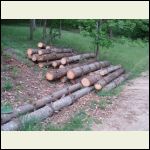
510haul.JPG
| 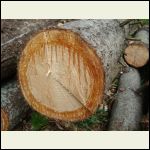
sapwood.JPG
| 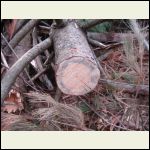
sapstain.JPG
| 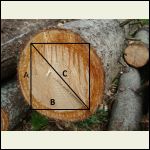
pythagoras.jpg
|
|
|
MtnDon
Member
|
# Posted: 11 May 2025 10:06pm
Reply
40 years ago, we had just moved to NM. One of my first jobs was at one of the last sawmills in the area. They produced a lot of 1x4 & 1x6 T&G pine as well as large pine timbers. My job the first day was pulling the boards with the most bluestain as they came out of the T&G moulder. Those sold for a premium price compared to the boards with no bluestain.
|
|
DRP
Member
|
# Posted: 12 May 2025 09:06am - Edited by: DRP
Reply
I've seen it sold as denim pine. It is not one of the rotting fungi, it is a sugar eater. It is a sign that conditions are right for the rotters to move in if the wood doesn't get dryer faster. I've seen what its little root tips look like punching through cell walls and in furniture production we tried everything we could think of to remove it to no avail... so the appeal is gone for me 
We had one client that requested blue pine logs for his log home. They were only too happy to dump them on our job. The logs were air dried and the fungus was dormant when they arrived but before we got the roof on they got well rained on and "bloomed". Our client sanded the logs when it was dried in but did not wear a respirator. That was not a good move. A month or so ago we were prepping a bed to plant chestnuts for a trial. As my wife was blending the soil mix they specified I commented that she should be wearing a respirator and never looked to see that she did. Severe bronchitis, annie-B's and steroids later. I guess both would be farmers lung, do be careful around dust.
Fungi need for the wood to be above fiber saturation point, there needs to be free water available to feed them. That is the visible damp point as well, below that is bound water tied up within the chemistry of the cell wall, not really available to fungi. That point is in the mid 20-ish moisture content range for most species of wood which is the reason for the KD19 stamp on lumber, kiln dried, 19 percent moisture content, below the fungal zone.
|
|
DRP
Member
|
# Posted: 17 May 2025 09:33pm
Reply
I've had to run the job this week, which was fine, it rained all week. I went ahead and harvested what I could get out ahead of the rain in the garden pines. I have a pile of logs, a pile of "public" work and temps that will turn the logs blue sooner than later.
The first pic below is of some young, smooth bark on a pine branch. Notice where the protective skin is scraped you see bright green, chlorophyll. Under that young bark on many trees is the same thing. That is the winter leaf. Hardwoods drop their leaves to avoid desiccation and freezing in winter, pines have waxy coated needles and can survive to higher latitudes and altitudes, but all trees continue to carry on business through the winter. The myth about sap going down in winter is just that, cells do not survive embolism. If a water column is broken and airlocked from root to stoma or lenticel in the bark, that entire column dies. It is a capillary tube, when a molecule of water leaves the leaf it pulls everyone in the chain below it, all the way to the roots, up one notch, ready to repeat. Anyway, look at the bark on a cherry or birch, the horizontal lines are lenticels, the young bark's equivalent of a leaf's stoma, the lips the tree exhales through.
The second pic is of a couple of tulip poplar flowers, they are blooming now. It is not one of the true poplars but is in the magnolia family. With the demise of the chestnut it is the largest eastern tree.
oh, which comes back around to, how tall could that capillary water column be before the molecular bonds just can't hold it together? Some scientists did the math and came up with the answer then looked around, the height of a redwood  . .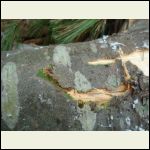
chlorobark.JPG
| 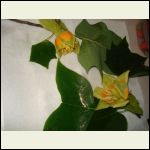
PoplarFlower.JPG
|  |  |
|
|
DRP
Member
|
# Posted: 21 May 2025 07:31am
Reply
The last couple of days have been a bummer on the homemade wood front. We have a good bit of red oak stored under roof in a large open sided shed. We put 2 bundles in the kiln a week or so ago and I loaded it and took it to the job Monday. The best I can tell the 8' stack was exposed to rain several times, maintained some level of "high" moisture and was attractive to powderpost beetles. Then my guess is, being out of spec moisture-wise it was dried too aggressively for the moisture content and is full of surface checks. Dimensional firewood  . The 12' bundle thus far appears to be good. My guess is it was higher and more central in the shed. . The 12' bundle thus far appears to be good. My guess is it was higher and more central in the shed.
On the other front, the chestnuts sprouted  . We're part of an experiment hoping to find blight resistant genetics in batches of seed. In the pic below the left row is Chinese chestnuts for controls and then 3 families of American trees. We'll record germination and mortality for 3 years. We'll inoculate these with blight at 2 years (I believe, need to review before then!) Then we'll record time to mortality and amount of oxalic acid produced by the blight. Turns out wood bleach is how the blight kills the tree. I use oxalic acid to remove discoloration in wood like metal stains in oak or cedar. If any survive they really want those trees back to grow out and use in the next round. The ones with some resistance will be crossed and seeds re-released. Where we are the trees are actually always being inoculated with blight, it's still in the woods all around us. If you see a bell bottomed scarlet oak, chances are it is carrying blight. There are also stumps still sprouting from the roots. The trees have been gone for a century, but some roots are still hanging on and will send up a sapling that lasts a few years. Hopefully they'll find that lucky nut. . We're part of an experiment hoping to find blight resistant genetics in batches of seed. In the pic below the left row is Chinese chestnuts for controls and then 3 families of American trees. We'll record germination and mortality for 3 years. We'll inoculate these with blight at 2 years (I believe, need to review before then!) Then we'll record time to mortality and amount of oxalic acid produced by the blight. Turns out wood bleach is how the blight kills the tree. I use oxalic acid to remove discoloration in wood like metal stains in oak or cedar. If any survive they really want those trees back to grow out and use in the next round. The ones with some resistance will be crossed and seeds re-released. Where we are the trees are actually always being inoculated with blight, it's still in the woods all around us. If you see a bell bottomed scarlet oak, chances are it is carrying blight. There are also stumps still sprouting from the roots. The trees have been gone for a century, but some roots are still hanging on and will send up a sapling that lasts a few years. Hopefully they'll find that lucky nut.
|
|
jsahara24
Member
|
# Posted: 21 May 2025 08:37am
Reply
Very interesting on the Chestnuts, look forward to hearing the outcome of your experiment.
|
|
gcrank1
Member
|
# Posted: 21 May 2025 11:57am
Reply
Good Stuff!
Almost like listening to a college seminar 
|
|
MtnDon
Member
|
# Posted: 21 May 2025 08:41pm
Reply
Quoting: DRP We're part of an experiment hoping to find blight resistant genetics in batches of seed.
Is that with The American Chesnut Foundation? The USFS? Or some other organization. I have been keeping track sporadically. There do seem to be a few places working on the problem. A slow process. Best of good luck!
|
|
DRP
Member
|
# Posted: 21 May 2025 09:16pm
Reply
Thanks! I'm glad you're enjoying the ramble  . I was kind of born in sawdust and figured I see cool stuff in wood and trees most people have just never thought about. From talking about trees carrying on photosynthesis in winter and not being completely dormant... need to remember to find a frost check to talk about. . I was kind of born in sawdust and figured I see cool stuff in wood and trees most people have just never thought about. From talking about trees carrying on photosynthesis in winter and not being completely dormant... need to remember to find a frost check to talk about.
But today was back at the job. We made it through Helene, an ice storm, winter... and the roof started leaking again this week, the patches of last year are done and so is the old roof. So I went in to meet the commercial roofers, or "I got a raise today, about 25 feet  ". ".
Then I sorted through the ugly 8' stack of red oak and thought you might enjoy seeing some defects. The first pic is the setup. I've moved my 3 phase unisaw in. I won this in an auction a dozen years ago but never hooked it up. There is 3ph here so I drug it out and, oooh, what a saw. The 12' stuff is in the background and I'm going through the 8' pile. Those Lineberry railroad carts were in every furniture and cabinet shop I worked in. At one company my first job was on "the ponderosa", an entry level job, I was a cartwright fixing and modifying all the material carts in the factory.
The first pic is of some of the surface checking. The face you are looking at is roughly a tangential slice to the growth rings, so you are seeing the ends if the rays as short, grayish "chicken scratches". Notice that cross cell intersection is the point where checks form, it is the weak point. As your eye follows the checks and then the rays you are also following the true grain direction rather than the figure which is what fools many people when trying to read the grain. Notice how the grain swirls around the old branch and then becomes straight as you move away from that area. Think about if you sawed near that swirling grain and put it on the edge rather than the middle of a timber, the lumber would be weaker than if the saw line can be out where the grain along the edges is straighter again. Now of course this is trim, I need to cut around most knots and I'm hoping the checks are shallow enough to plane out. I think I'll put another pic of checked straighter grain to show and then catch the bugs in the next post, I think there were at least 3 flavors.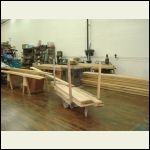
OakTroubles.JPG
| 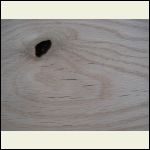
RayChecks.JPG
| 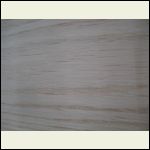
CheckedStraightGrain.jpg
|  |
|
|
DRP
Member
|
# Posted: 22 May 2025 09:01pm
Reply
Don, I was typing when you posted. Yes this is associated with the ACF (they are about 50 miles west) and the nearby state forest that has several generations of experimental trees going, from the emails it looks like there are people at least out to the midwest.
"We are going to follow methods used by Dorena Genetic Resource Center that they used to breed trees against pine bark rust." When working near UW Madison and northern IL there were several large-ish live American Chestnuts in the area. The residual blight in the forest must be low.
The holes in the oak were from a few different insects. The first pic is, I believe, from the oak timberworm. Usually a "shotgun blast" of holes of different diameters from the larvae on the getaway and return trips.
https://en.wikipedia.org/wiki/Arrenodes_minutus
Next pic is from an ambrosia beetle. There are usually 2 or 3 holes in a spot. The holes are black inside. This beetle is just boring to farm fungus. It feeds on the black fungus that is growing on wet, sweet, wood. At mating time he flies up and away to meet new girls, wooing them by raising his armpit and showing off his special fungus. This beetle and its larvae die when the wood dries. These guys can hit overnight and all I see the nect morning are dust volcanos and beetle butts. pic 3 is from some poplar the morning after sawing. https://en.wikipedia.org/wiki/Ambrosia_beetle
4th pic is a mix of ambrosia and then the one that worries us the most. small clear holes, smaller than ambrosia, larger than baby timberworm... a ball point pen ball will barely not fit in a true lyctid powderpost beetle hole. This varmint survives low moisture content and can live in a house for generations, slowly consuming the structure.
https://en.wikipedia.org/wiki/Powderpost_beetle
The frass from PPB's was colonial baby powder. The piles of very fine dust accumulated on the top of each row of logs, always readily at hand in the old cabin  . .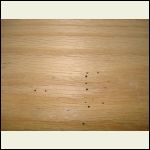
OakTimberworm.JPG
| 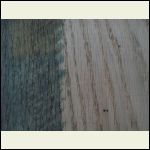
Ambrosia.JPG
| 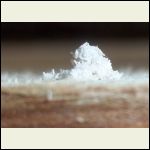
beetlevolcano.jpg
| 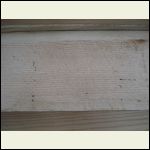
PPBnAmbrosia.JPG
|
|
|
MtnDon
Member
|
# Posted: 23 May 2025 05:59pm
Reply
Quoting: DRP The frass from PPB's was colonial baby powder.
I love bits of history like that. 
|
|
DRP
Member
|
# Posted: 25 May 2025 09:35am
Reply
45 this morning, and yesterday. Row cover on the 'maters and tender stuff. My sweetwife and dog are off looking for newts, 7 the other morning but I think too dry today.
The cool made me remember frost checks, this is a pic of one that is from probably 20 or so winters ago, it is about healed over but you can see the ridge in the bark, slightly left spiral grain in that red oak. The flame azalea, native deciduous azalea, is about done blooming.
A frost check is usually on the south- southwest face of trees. It happens on a below freezing day, some degrees below air temp-wise. Bright sunny afternoon, the solar is at peak shining on the dark tree, warming it, the sap thins its antifreeze solution and begins metabolism, making food, disposing of waste. When trees cannot do this they drop out of the landscape. Conifers can survive at the coldest latitudes and altitudes, and then you hit the tree line.
Anyway, if you are in the woods on one of these bright cold but sunny afternoons... and a large solid cloud blocks the sun for some minutes. In a very few minutes the gunshot sounds start as the trees full of thin sap, freeze and split.
Not being a cross grain break it doesn't really damage the living tree too much, but it is a wide open wound for insects and fungi to enter. Where we heal, trees do not, they can only cover injury. This pic is kind of neat in that respect. The cover of this wound is becoming complete. Reading trees and logs is being able to see those old checks, knots, injuries that are hiding within the log. Turned one way there will be a couple of cracked firewood boards. Turn the log the wrong way on the mill and every board on the way to the heart would probably be cracked down the middle. So as you walk the woods, pay attention to that afternoon sun aspect of the trees and look for frost checks.
|
|
DRP
Member
|
# Posted: 27 May 2025 08:02pm - Edited by: DRP
Reply
Not trees but sort of related. Working in town we need to corral the dust. I was working on the blower for the planer today. I was given this wreck some years ago and have never gotten it going. The impeller is a material handler, somewhere between a radial blade and a backward inclined blade, which is less noisy. When I got it, it must have eaten a bunch of knots, chunks or rocks, all the blades were bent and cracked, one was missing.
I bent and banged the blades into rough shape and fabricated a replacement then welded everything back together again. This afternoon I ground and welded, spun and spun again looking for the heavy side and finally got it pretty well balanced. The old motor was a 3 horse 460 volt 3 phase. I have a 3 hp single phase on the way.
Which brings back a memory from 45 years ago. I was setting up a 5 head molder. it could plane or put a pattern on all 4 sides and then had a universal back head that could hit anywhere. The suction system was a big ash fan outside, sort of like the pic but godzilla sized, running off a 40hp motor. There were five 6" suction pipes hanging down from the main suction line to the molder, one for each cutterhead. They were plastic flex pipe that could be pulled off of each dust hood so I could get to the cutterheads easily. I had made some adjustments to the machine, the suction tubes were dangling but the fan was on, a quick stop. While it was down I waxed the bed which was usual whenever down.
Now I don't know if any of you have measured the diameter of a yellow can of Johnson's Paste Wax, (which I may now have the last can of but that is another story). Anyway, IF you have measured the can and compared it to the inside diameter of a 6" suction tube... yup, it'll go. And being a snug fit, it goes faster than your paycheck up the bank tube downtown!
I'm not sur what possessed me, I was jogging underneath the suction tube down the length of the shop, hearing the can banging along ahead of me, it was moving! Up through the wall and into the fan outside where I heard a terrible gnashing of metal. The fan blew the dust, and my can, and a fan blade, up to a cyclone where the heavy stuff like sawdust, fan blades, inside out wax cans and such drop out of the vortex into a can or truck in this case and the air goes out the top. In the case of the little blower in the pic the air out the top goes to a couple of filter bags as it is in the room with us. The fan at my sawmill just blows the wet dust into a pile that I scoop up.
Anyway, I spent the afternoon welding the new blade on then spinning the impeller and noting the heavy side, grinding it or welding the light side until it was as close to balanced as I could get it. That has worked in the past... knocking on wood.
|
|
MtnDon
Member
|
# Posted: 28 May 2025 11:17pm
Reply
Quoting: DRP Johnson's Paste Wax,
SC Johnson paste wax... I remember my Mom having that way back when I was a kid. The old early 1900s house had maple hardwood floors everywhere except the kitchen. And a heavy weighted felt pad push-pull polishing tool.
|
|
DRP
Member
|
# Posted: 29 May 2025 09:36pm - Edited by: DRP
Reply
I just went looking, a Walmart 3rd party ad has a can for $257. From what I heard the VOC rules finally did it in. I'm on the second can of Minwax down at the planer and it works ok, a good bit harder.
Not really wood but more woods stuff. The deer are dropping fawns. I was driving down to the sawmill shop yesterday about spooky time. A doe was approaching the truck, which is not uncommon, they are curious animals, but as I continued towards her she kept coming, that is unusual. A revved it a little to spook her and as she turned I saw somebody's head... oops' I had interrupted her. I hope it turned out ok.
Today our dog was barking hard up the mountain behind the barn. My wife went up and he had faced off with something over a freshly killed fawn. They comprise a large part of the black bear diet this time of year. If he was challenging a bear, it was a yearling!
|
|
MtnDon
Member
|
# Posted: 31 May 2025 12:09pm
Reply
I think Minwax is effective and about as low a cost as one can find.
Just for the heck of it, here's some wood, a standing ponderosa near us.
|
|
DRP
Member
|
# Posted: 1 Jun 2025 08:15pm - Edited by: DRP
Reply
Nice tree, nice location too.
There is the story, myth, whatever, in the mountains of the rare red walnut, a black walnut with red wood. I went a couple of counties over several years ago to check out a 1700's log cabin that supposedly had red walnut logs in it. In the end I conceded that there was a mahogany hue to the wood and brown contains red, so who am I to say they were not the elusive wood.
While cleaning up in the shop the other day I happened on this scrap of walnut. The curve of the rings is a little deceptive. Bugs eat sapwood, the red is in the sapwood. The heart is to the right, the bark to the left in the pic. Is it just an early component color of the brown?
BTW when sawing walnut the heartwood is initially green then turns brown after exposure to the air for a little while. The sapwood is a creamy white but turns blue for a little while after sawing... there's some cool stuff going on there.
The other thing to notice in this pic is that walnut is semi ring porous, the oaks I've shown mostly are distinctly ring porous. This is a good article on the difference and the way they evolved to use water differently as survival strategies.
https://extension.psu.edu/how-do-ring-porous-trees-differ-from-diffuse-porous-trees#: ~:text=The%20common%20ancestor%20of
|
|
| . 1 . 2 . 3 . 4 . >> |

